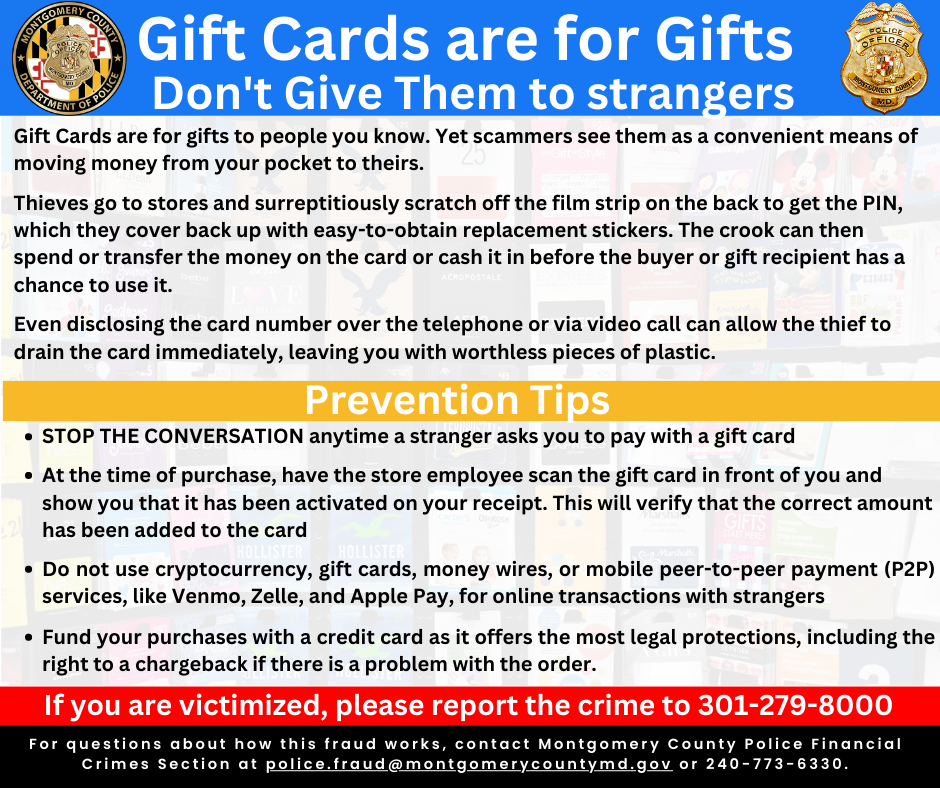Gift Cards, Cryptocurrency, Payment Apps, and Other Hard-to-trace Payment Methods
 Gift Cards are for gifts to people you know. Yet scammers see them as a convenient means of moving money from your pocket to theirs.
Gift Cards are for gifts to people you know. Yet scammers see them as a convenient means of moving money from your pocket to theirs.
STOP THE CONVERSATION anytime a stranger asks you to pay with a gift card, cryptocurrency, or other hard-to-trace payment methods. These payment methods (see below) carry significant risks, so it's essential to use them cautiously, especially when making large purchases or transactions. Government agencies never ask for payment via these methods; businesses rarely use them. Any such payment method should be seen as a sign of fraud.
Gift cards aren’t the only payment method that should raise red flags when strangers ask for them. The payment methods listed below are difficult to reverse or refund. Nor do they provide much safety to consumers. Credit cards are safer, thanks to consumer protections established by law.
What are these Payment Methods that are Hard to Trace?
- Wire transfers: Once a wire transfer is completed, it can rarely be canceled or refunded. This is because wire transfers involve moving funds from one bank account to another without intermediaries.
- Cash payments: Once you make a cash payment, it is hard to get it back once you hand over the cash. Therefore, it is essential to be careful when making cash payments, especially for large sums of money.
- Cryptocurrencies: Cryptocurrencies are decentralized digital currencies that operate on a blockchain network. Depending on the type of cryptocurrency, these transactions are hard to reverse and hard to trace, and can rarely be canceled or refunded.
- Money orders: Money orders are like checks but are prepaid and guaranteed by the issuer. Once a money order is issued and paid, it cannot be easily canceled or refunded.
- Mobile peer-to-peer payment (P2P) services, like Venmo, Zelle, and Apple Pay, aren't meant for commercial use—which online transactions are. If a payment service flags a transaction as commercial, you could be banned from using the service, and your funds held temporarily.
Gift Cards are for Gifts, So Don’t Give them to Scammers.
Even disclosing the card number over the telephone or via video call can allow the thief to drain the card immediately, leaving you with worthless pieces of plastic.
Be alert to gift cards in a self-checkout kiosk. A scammer can scan the gift card PIN and walk away, hoping an unwary shopper will pay for the gift card later. Once the card has value authorized, the scammer can use the PIN to claim the card amount remotely, perhaps before the unwary shopper leaves the store.
According to the American Association of Retired Persons (AARP), “… thieves go to stores and surreptitiously scratch off the film strip on the back to get the PIN, which they cover back up with easy-to-obtain replacement stickers… The crook can then spend or transfer the money on the card or cash it in before the buyer or gift recipient has a chance to use it.” One in 4 respondents to AARP’s survey said they had given or received a gift card with no value.
Here are some tips on how to pay safely
- When buying on a legitimate online marketplace, use the payment service the site recommends.
- Fund your purchases with a credit card as it offers the most legal protections, including the right to a chargeback if there is a problem with the order.
- Review the website's user agreements, terms and conditions, and consumer protections.
- Major payment services offer a purchase protection program that covers buyers and sellers for most items exchanged online.
- Do not use cryptocurrency, gift cards, money wires, or other hard-to-trace payment methods.
- Always double-check the payment details before sending money, and only use reputable payment methods and services.
Where to Report a Scam
- Montgomery County Police Department at 301-279-8000
- Federal Trade Commission (FTC) at https://www.ftc.gov/complaint.
- Better Business Bureau (BBB) at https://www.bbb.org/scamtracker.
- Internet Crime Complaint Center (IC3) at https://www.ic3.gov.
- American Association of Retired Persons (AARP) fraud helpline at 1-877-908-3360 or https://www.aarp.org/money/scams-fraud/fraud-watch-network/
There is a more extensive list of reporting agencies at How to Report Fraud.
References for Learning More
- AARP. (April 1, 2021). How Scammers Like to Be Paid. Retrieved from https://www.aarp.org/money/scams-fraud/info-2021/preferred-ways-to-pay.html
- Better Business Bureau. (n.d.). BBB Study: Gift cards are an increasingly popular tool for scammers. Retrieved from https://www.bbb.org/article/news-releases/23735-bbb-investigation-gift-card-scams
- Consumer Reports. (n.d.). How to Safely Pay for Goods and Services With Someone You Don't Know. Retrieved from https://www.consumerreports.org/digital-payments/how-to-safely-pay-for-goods-and-services-with-someone-you-dont-know/
- Consumer Reports. (n.d.). How to Avoid Gift Card Scams. Retrieved from https://www.consumerreports.org/gift-cards/how-to-avoid-gift-card-scams/
- Federal Bureau of Investigation (FBI). (2024 May 6). Cyber Criminals Phishing and Smishing US Retail Corporations for Gift Card Fraud. Retrieved from https://www.ic3.gov/Media/News/2024/240507.pdf.
- Federal Trade Commission. (2023). Gift Card Scams - What To Do https://www.youtube.com/watch?v=nVduXLC-HHI
- Federal Trade Commission. (2023). Gift cards are for gifts. Only gifts. Not payments. https://www.youtube.com/shorts/id1cY2H4EAI
- Federal Trade Commission. (2023). Don't do this when wiring money! https://www.youtube.com/shorts/sLevhrdSJAs
- Federal Trade Commission. (2023). Only Scammers Demand You Pay Only with Crypto https://www.youtube.com/watch?v=KgtyEPNWmPk
- Federal Trade Commission. (2023). Solo los estafadores dicen que tienes que pagar con criptomonedas https://www.youtube.com/watch?v=OiyP2B--TKY
- Federal Trade Commission. (2023). Holiday Gift Card Scams https://www.youtube.com/shorts/-2q55EQjXA8
- Federal Trade Commission. (2018). Report Gift Cards Used in a Scam https://www.youtube.com/watch?v=HfHI6ToZff4
- Federal Trade Commission. (2023). Usando aplicaciones de pago https://www.youtube.com/watch?v=Wi2jLaRDf8w
- Federal Trade Commission. (2023). Don't Get Scammed Using Payment Apps https://www.youtube.com/watch?v=sr7MgiIwxDg
- Federal Trade Commission. (2023). Hacer una transferencia de dinero es como enviar dinero en efectivo https://www.youtube.com/watch?v=jjY8fAFJ24M
- Federal Trade Commission. (2023). Beware of 'Money Wiring' Scams https://www.youtube.com/watch?v=gsTrV41neJU
- Federal Trade Commission. (2023). Estafas usando tarjetas de regalo: qué hacer https://www.youtube.com/watch?v=BkKD3G5zAO0
- Federal Trade Commission. (2023). Las tarjetas de regalo son para regalos, Solo regalos. No son para hacer pagos. https://www.youtube.com/shorts/SMGXR4eH2vM
- Federal Trade Commission. (2019). Reporte las tarjetas de regalo utilizadas en una estafa https://www.youtube.com/watch?v=Dh-g2Mr8fGs
- Federal Trade Commission. (2021, December 8). Scammers Prefer Gift Cards, but Not Just Any Card Will Do. Retrieved from https://www.ftc.gov/news-events/data-visualizations/data-spotlight/2021/12/scammers-prefer-gift-cards-not-just-any-card-will-do
- Federal Trade Commission. (2023). Avoiding and Reporting Gift Card Scams. Retrieved from https://consumer.ftc.gov/articles/avoiding-and-reporting-gift-card-scams
- Hebert, A. Do you use payment apps like Venmo, CashApp, or Zelle? (August 14, 2023). Federal Trade Commission. https://consumer.ftc.gov/consumer-alerts/2023/08/do-you-use-payment-apps-venmo-cashapp-or-zelle-read
- Noyes, D. (2025 October 9). San Jose dad lured to Bitcoin ATM by scammer claiming to be son in latest scheme to steal money. ABC News KGO San Francisco. Retrieved from https://abc7news.com/post/bitcoin-atms-what-know-latest-scheme-steal-thousands-innocent-victims/17974569/.
- Oramas, J. (2025 July 10). New Zealand Cracks Down on Cash Crime with Crypto ATM Ban and $5K Transfer Cap. Crypto News Australia. Retrieved from https://cryptonews.com.au/news/new-zealand-cracks-down-on-cash-crime-with-crypto-atm-ban-and-5k-transfer-cap-129829/.
- Silverman, C., & Elkind, P. (2022, January 17). How Walmart’s Financial Services Became a Fraud Magnet. ProPublica. https://www.propublica.org/article/walmart-financial-services-became-fraud-magnet-gift-cards-money-laundering
- Stokes, K. (2024). Peer-to-Peer Payment Apps: Popular With Consumers & Criminals. AARP Fraud Watch Network.
- The Washington Post. (December 27, 2023). Target store in Northern Virginia hit by gift card scam. https://www.washingtonpost.com/dc-md-va/2023/12/27/gift-card-scam-arrests/
Gift Card Scam Flyer
Right-click on the image below and download it to distribute as a hard copy of the flyer.


